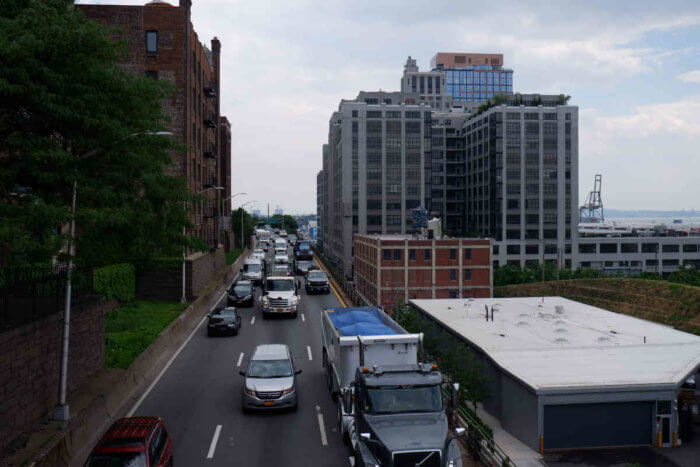Gov. Kathy Hochul has signed into law a bill authorizing the use of brand-new technology to monitor and issue violations to overweight trucks on the Brooklyn-Queens Expressway’s crumbling cantilever in Brooklyn Heights.
Introduced by state Sen. Brian Kavanagh and Assemblymember Jo Anne Simon, the bill amends traffic law to allow for the launch of a pilot “weigh in motion program,” which will prompt the city’s Department of Transportation to install up to 16 weigh stations on the BQE between Atlantic Avenue and Sands Street. The technology will flag trucks exceeding the roadway’s 80,000-pound limit and allow authorities to issue violations to the vehicle’s owners.
“We need to ensure resilient and safe infrastructure for all New Yorkers,” Hochul said, exclusively to Brooklyn Paper. “New Yorkers deserve better than the current state of the BQE, which is why I’m proud to sign legislation authorizing City officials to monitor and penalize truck drivers who break the law and make our roads less safe.”
A 2020 report commissioned by Mayor Bill de Blasio found that more than 11 percent of the trucks traversing the congested highway in a three-month period violated the weight limit, and that some weighed as much as 170,000 pounds. Overweight trucks cause significant wear-and-tear to roads and bridges, especially those already in poor condition like the BQE.

Carlos Scissura, one of the report’s authors, said the three-level cantilever along the Brooklyn waterfront is in “dire condition,” and that parts of the road could become unsafe for drivers within five years. The report recommended that the city reduce the number of lanes on the heavily-trafficked expressway and work with city and state police to more diligently prevent overweight trucks from using the delicate structure.
In February, de Blasio signed an executive order allowing the city to fine drivers up to $7,000 for driving an overweight vehicle on the span.
“This legislation is vital to extending the useful life of the BQE, and ensuring the safety of all drivers and passengers of vehicles that use this roadway,” Kavanagh said, in a statement. “The deployment of weigh-in-motion technology will effectively deter trucking companies from engaging in destructive and unsafe behavior, and is likely to become a standard enforcement tool.”
According to the text of the bill, the city and state departments of transportation would work together on the design, installation, and maintenance of the weigh stations, and each violation will be reviewed by a technician for accuracy. Only trucks exceeding the weight limit by ten percent or greater will be fined.
“Creating 21st-century infrastructure is critical and the BQE is a linchpin of the NY Metropolitan area’s transportation network and the region’s economy,” Simon said. “Illegally overweight trucks have contributed significantly to the deterioration of the BQE triple cantilever, so the importance of enforcing the legal weight limits cannot be overstated. Removing overweight trucks from the BQE will extend its lifetime and allow us time to envision a long-term solution for the entire BQE corridor that reduces reliance on polluting freight trucks and prioritizes climate justice.”

Earlier this year, de Blasio announced the city’s plan to keep the cantilever open and operational until 2040, well past its projected lifespan. In addition to completing urgent repairs on the retaining wall and waterproofing the structure’s joints to prevent further corrosion, Hizzoner said he hoped the automatic weigh stations would be installed under the leadership of the next administration.
“Overweight and off-route trucks are a menace — they destroy our infrastructure, damage the quality of life in our neighborhoods and contribute to climate change,” said city DOT commissioner Hank Gutman.” This is but one of many areas in which the use of automated enforcement techniques can help keep the streets and highways of New York safe for all who use them.”
























